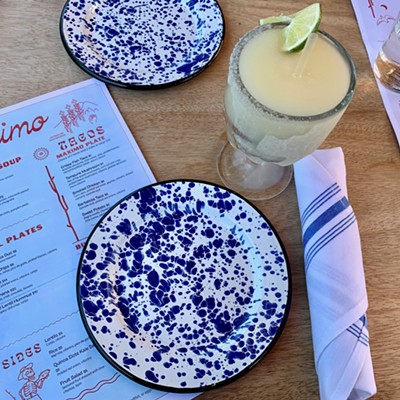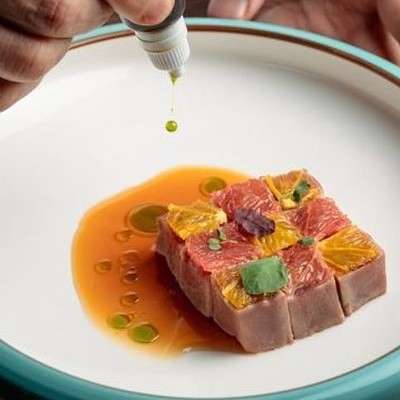You may have seen the little lockbox near the meats and cheeses in Spec's downtown deli, its secured contents gleaming up from their cool environs in tiny, metal-capped glass jars. That lockbox cradles some of the best caviar in the city, beckoning you to buy just one to share among friends during your New Year's Eve celebration. But if you're not a caviar connoisseur, would you know where to start?
While it's long been considered a luxury item here in the United States, the truth is that caviar -- in all its forms -- is becoming more inexpensive and accessible with every passing year, just as it's been in other countries for years.
"Caviar is not necessarily a luxury item in most of the world where it is produced and consumed," says Pablo Valqui, the deli and dry foods buyer at Spec's. "It, however, has a reputation as such, especially in the Western world. The Capelin, Lumpfish and Salmon caviar consumed in Scandinavian and Black Sea Shore countries are cheap and still taste good to the people that consume them."
But what about the stuff Americans hear and read about that's served in the finest restaurants? The Ossetras and Sevrugas of the world?
Those are becoming more affordable too, says Valqui.
"Caviar prices are expected to drop due to farm-raising in countries less known for caviar, like Germany," Valqui says, "and also because producers are heavily working on marketing sturgeon as a fish to eat, increasing revenue on the product side."
In the old days, fish were caught only for their roe (the sac of eggs that comprises caviar) and the rest of the flesh itself was throw into the trash or used as filler. "Think fish sticks," Valqui says."
Now, modern technology -- along with farm-raising fish specifically for their roe -- could mean that fish would no longer be trashed after harvesting one sac of roe. "The newest development expected to drive prices down is the surgical removal of the roe and the possibility of a second harvest on one fish," says Valqui.
Caviar comes in many different varieties, from roe that's dyed red or black with artificial color to make it more festive (the transparent, colorless roe aren't as pretty, marketers reason) to pasteurized caviar that's completely shelf-stable.
"Furthermore," Valqui says, "caviar can be from the lowest priced Swedish or Icelandic bright red Capelin caviar at $3.79 for a 3-ounce jar, to the most expensive River Beluga at $139 per ounce." True Beluga caviar isn't currently available in the United States due to the Endangered Species Conservation Act (a.k.a CITES), but River Beluga -- a replacement which grows in, you guessed it, rivers -- makes a great substitute.
In fact, the most expensive caviar you can currently buy in the United States is Sevruga, for roughly $100 an ounce, followed closely by Ossetra for $75 an ounce.
So let's say you're going to splash out on some Sevruga for your first time around. Do you eat the caviar alone? With accoutrements? On a piece of toast? With a spoon or a fork?
"For someone that is going to have caviar for the first time in their life, it would be best to eat it the standard way," instructs Valqui. "On a blini -- a small Russian pancake -- with crème fraîche, and drink brut Champagne or vodka with it. Blinis are an essentially flavorless means of transportation, the crème fraîche reduces the fishy taste inherent to all caviars, the vodka washes down the mix, and the alcohol cuts through the fat of the crème fraîche and further reduces the fishy taste. A brut champagne's acidity will do the same."
Valqui doesn't suggest starting with the big, braggart's jar of caviar, though. He'd rather see people start in the $30 per ounce price range. "At that price," he says, "you get 1 ounce of American Hackleback -- also known as shovelnose sturgeon."
Regardless of which caviar you end up buying for the New Year, there are a handful of pitfalls to watch for when serving those sweet, nutty, briny, delicious eggs.
Don't:
- Use silver or metal spoons, as they oxidate and lend a metallic taste to the eggs, thereby ruining their precious flavor.
- Store fresh caviar anywhere except the coldest part of your fridge. (If you can put an ice pack on/around it, that's even better.)
- Keep caviar that's been open for more than two or three days.
- Serve it with beer. ("That's just wrong to the beer," says Valqui.)
Do:
- Use a mother-of-pearl spoon to serve the caviar. (Bone, glass or even wood will do in a pinch.)
- Try to serve the caviar from the original jar, as the eggs pop easily if transferred without care and the jar itself is generally the traditional (and prettiest) serving method.
- Keep the caviar on ice while serving. Crushed ice generally works best. (Get the ice from Sonic if you're feeling extra classy.)
Follow Eating Our Words on Facebook and on Twitter @EatingOurWords





